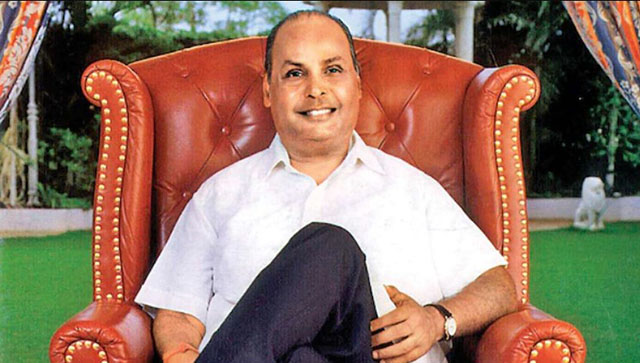Industrialist and entrepreneur Dhirubhai Ambani not only had a fantastic business sense, but he also had a deep bond and commitment towards the environment and wildlife. In a recent book, The One and Only Dhirubhai Ambani [Navbharat Publication, Ahmedabad] close associate and parliamentarian Parimal Nathwani reveals how Dhirubhai created the largest mango orchard in Asia at Jamnagar. [caption id=“attachment_13421222” align=“alignnone” width=“640”] Screenshot from amazon.co.in[/caption] In 1997, when the Jamnagar refinery complex was under construction, some environmental concerns were raised. When the local court issued some guidelines, Dhirubhai told Nathwani, “Parimal, we should not plant only one lakh or two lakh trees, but we must aim at planting more than two million trees and create such greenery that would become a centre of attraction. People should come to see the greenery rather than the refinery.” Nathwani said taking a cue from his desire and vision, over three million trees were planted. Large wastelands near the Jamnagar refinery were converted into a green belt. A mango orchard of 81,000 trees having over 200 species came into life. The orchard was named Dhirubhai Ambani Lakhibag Amrayee, having various varieties such as Junagarh Kesar, Ratnagiri, Alphonso, Sindu, Neelam and some European and Israeli varieties namely Tommy Atkins and Kent and Lily, Keitt, and Maya from Israel. In addition, there are over half a million timber trees in addition to separate pomegranate and mixed fruits orchards which were earlier not grown in Jamnagar, records Nathwani who is currently Director-Corporate Affairs at Reliance Industries Limited and a member of the Rajya Sabha. The word Lakhibagh is inspired by the famous mango orchard created by Mughal Emperor Akbar in the 16th century at Darbhanga in Bihar. The mangoes from Dhirubhai Ambani Lakhibag Amrayee are now sold locally as well as exported globally. Spread over 600 acres, the orchard gets water from Reliance Industries Limited’s desalination plant that purifies the seawater. Due to arid land, water harvesting and drip irrigation technology are used. Nathwani says he learnt a great deal about time management and commitment from Dhirubhai. “‘You have to use 24 hours to the fullest’ was his mantra. I realised this while acquiring land for Jamnagar’s refinery project. I remember I had asked for six months’ time to accomplish the acquisition of approximately 7,000 acres of land. Dhirubhai however, granted me only three months. It was a tough task indeed. I had to meet as many as 1,100 farmers who were holding 7,000 acres of land to be acquired for the Jamnagar refinery. At the end of three months, I realised that I had acquired only 30 per cent of the land required. Dhirubhai however, granted me another three months,” Nathwani reminisces, pointing out that had he been given six months to perform at the beginning, he would have taken that much time just to achieve 30 per cent of the target. “I thus learnt a great lesson in time management, commitment and involvement from Dhirubhai,” admits Nathwani. Nathwani recalls how Dhirubhai would often tell him that if you dream about something, you could make it. “He made us dream, he taught us how impossible could be made possible,” Nathwani writes, pointing out how one million mangroves were planted in Jamnagar to augment and protect marine ecology. Nathwani remembers how Dhirubhai was excited when a leopard was spotted in the green forest created by him. “The animal had lost its way from nearby Barda Hills and was trying to find a shelter. The forest department had tried to trap the animal. Dhirubhai was so thrilled with the news of a leopard appearing in the refinery’s forest that he once again said, ‘Parimal, your forest and greenery have become more popular than the refinery. People would remember Reliance for the green pastures rather than the refinery.’” According to Nathwani, Dhirubhai’s idea of happiness was not in posh hotels or big cities but in forest hamlets and country food. “In 1995, Dhirubhai was visiting his native place Junagarh district. One of the days during his stay in Sasan Gir happened to be his birthday. One would not believe but on his birthday, he preferred to take his meals not in Taj Gir Forest Hotel but right in the midst of forest hamlet and chose a typical country food – bajra roti, baked brinjal vegetable, butter, khichadi and buttermilk.” Dhirubhai was a true son of the soil. Often, he would organise ‘dayaro’ [special Bhajan session] where someone with the stature of a renowned folk storyteller Bhikudan Gadhvi would perform and Dhirubhai would enjoy till late at night. Nathwani’s book was launched by Gujarat Governor Acharya Devvrat in Gandhinagar in the presence of state Chief Minister Bhupendra Patel. The book has been published by Navbharat Publication in three languages: Gujarati, Hindi and English. In Hindi and Gujarati, the book is titled Ekmev Dhirubhai Ambani. Disclaimer: Firstpost is a part of the Network18 group. Network18 is controlled by Independent Media Trust, of which Reliance Industries is the sole beneficiary. The writer is a Visiting Fellow at the Observer Research Foundation. A well-known political analyst, he has written several books, including ‘24 Akbar Road’ and ‘Sonia: A Biography’. Views expressed in the above piece are personal and solely that of the author. They do not necessarily reflect Firstpost_’s views._ Read all the
Latest News ,
Trending News ,
Cricket News ,
Bollywood News , India News and
Entertainment News here. Follow us on
Facebook,
Twitter and
Instagram.
In a recent book, ‘The One and Only Dhirubhai Ambani’, close associate and parliamentarian Parimal Nathwani reveals how Dhirubhai Ambani created the largest mango orchard in Asia at Jamnagar
Advertisement
End of Article


)

)
)
)
)
)
)
)
)



